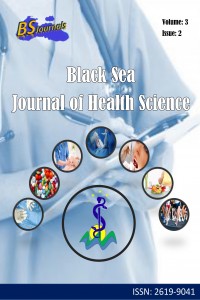Research Article
Year 2020,
Volume: 3 Issue: 2, 27 - 30, 01.04.2020
Abstract
References
- Bianconi A, Marcelli A, Campi G, Perali A. 2020. Ostwald growth rate in controlled Covid-19 epidemic spreading as in arrested growth in quantum complex matter. arXiv:2003.08868. Jung S, Akhmetzhanov AR, Hayashi K, Linton NM, Yang Y, Yuan B, Kobayashi T, Kinoshita R, Nishiura H. 2020. Real-time estimation of the risk of death from novel coronavirus (COVID-19) Infection: Inference using exported cases. J Clin Med, 9: 523, DOI: 10.3390/jcm9020523. Lipsitch M, Cohen T, Cooper B, Robins JM, Ma S, James L, Gopalakrishna G, Chew SK, Tan CC, Samore MH, et al. 2003. Transmission dynamics and control of severe acute respiratory syndrome. Science, 300: 1966–1970. Liu Y, Gayle AA, Wilder-Smith A, Rocklöv J. 2020. The reproductive number of COVID-19 is higher compared to SARS coronavirus. J Travel Med, 2020: 1–4, DOI: 10.1093/jtm/taaa02. Richards F. 1959. A flexible growth function for empirical use. J Exp Bot, 10: 290–301. Roosa K, Luo R, Chowell G. 2019. Comparative assessment of parameter estimation methods in the presence of overdispersion: A simulation study. Math Biosci Eng, 16: 4299–4313. Roosa K, Lee Y, Luo R, Kirpich A, Rothenberg R, Hyman JM, Yan P, Chowell G. 2020a. Real-time forecasts of the COVID-19 epidemic in China from February 5th to February 24th, 2020. Infect Disease Modell, 5: 256e263. DOI: 10.1016/j.idm.2020.02.002. Roosa K, Lee Y, Luo R, Kirpich A, Rothenberg R, Hyman JM, Yan P, Chowell G. 2020b. Short-term forecasts of the COVID-19 epidemic in Guangdong and Zhejiang, China: February 13–23, 2020. J Clin Med, 9: 596, DOI:10.3390/jcm9020596. Tian S, Hu N, Lou J, Chen K, Kang X, Xiang Z, Chen H, Wang D, Liu N, Liu D, Chen G, Zhang Y, Li D, Li J, Lian H, Niu S, Zhang L, Zhang J. 2020. Characteristics of COVID-19 infection in Beijing. J Infect, 80: 401–406, DOI: 10.1016/j.jinf.2020.02.018. Tunç T, Enöz S. 2018. Analysis of job satisfaction levels of police with structural eqution modeling: the case of Samsun. BSJ Eng Sci, 1(4): 134-139. Viboud C, Simonsen L, Chowell G. 2016. A generalized-growth model to characterize the early ascending phase of infectious disease outbreaks. Epidemics, 15: 27–37. Wang X-S, Wu J, Yang Y. 2012. Richards model revisited: Validation by and application to infection dynamics. J Theor Biol, 313: 12–19. Wu Z, McGoogan JM. 2020. Characteristics of and important lessons from the coronavirus disease 2019 (COVID-19) outbreak in China. JAMA, DOI: 10.1001/jama.2020.2648.
Year 2020,
Volume: 3 Issue: 2, 27 - 30, 01.04.2020
Abstract
The trend of COVID-19 and its reproductive number should be well examined because the transmission potential of novel coronavirus can reach high values. In this study the early stage of COVID-19 in Turkey between March 16 and March 28, 2020 was examined. Generalized Logistic growth model, Richards Model, and sub-exponential growth models were compared to estimate the trend of disease. Results showed that the reproductive number was between 2.00 and 2.45 at interested period. The best fitting model has been determines as sub-exponential growth model with scaling of growth parameter of 0.91.
Keywords
References
- Bianconi A, Marcelli A, Campi G, Perali A. 2020. Ostwald growth rate in controlled Covid-19 epidemic spreading as in arrested growth in quantum complex matter. arXiv:2003.08868. Jung S, Akhmetzhanov AR, Hayashi K, Linton NM, Yang Y, Yuan B, Kobayashi T, Kinoshita R, Nishiura H. 2020. Real-time estimation of the risk of death from novel coronavirus (COVID-19) Infection: Inference using exported cases. J Clin Med, 9: 523, DOI: 10.3390/jcm9020523. Lipsitch M, Cohen T, Cooper B, Robins JM, Ma S, James L, Gopalakrishna G, Chew SK, Tan CC, Samore MH, et al. 2003. Transmission dynamics and control of severe acute respiratory syndrome. Science, 300: 1966–1970. Liu Y, Gayle AA, Wilder-Smith A, Rocklöv J. 2020. The reproductive number of COVID-19 is higher compared to SARS coronavirus. J Travel Med, 2020: 1–4, DOI: 10.1093/jtm/taaa02. Richards F. 1959. A flexible growth function for empirical use. J Exp Bot, 10: 290–301. Roosa K, Luo R, Chowell G. 2019. Comparative assessment of parameter estimation methods in the presence of overdispersion: A simulation study. Math Biosci Eng, 16: 4299–4313. Roosa K, Lee Y, Luo R, Kirpich A, Rothenberg R, Hyman JM, Yan P, Chowell G. 2020a. Real-time forecasts of the COVID-19 epidemic in China from February 5th to February 24th, 2020. Infect Disease Modell, 5: 256e263. DOI: 10.1016/j.idm.2020.02.002. Roosa K, Lee Y, Luo R, Kirpich A, Rothenberg R, Hyman JM, Yan P, Chowell G. 2020b. Short-term forecasts of the COVID-19 epidemic in Guangdong and Zhejiang, China: February 13–23, 2020. J Clin Med, 9: 596, DOI:10.3390/jcm9020596. Tian S, Hu N, Lou J, Chen K, Kang X, Xiang Z, Chen H, Wang D, Liu N, Liu D, Chen G, Zhang Y, Li D, Li J, Lian H, Niu S, Zhang L, Zhang J. 2020. Characteristics of COVID-19 infection in Beijing. J Infect, 80: 401–406, DOI: 10.1016/j.jinf.2020.02.018. Tunç T, Enöz S. 2018. Analysis of job satisfaction levels of police with structural eqution modeling: the case of Samsun. BSJ Eng Sci, 1(4): 134-139. Viboud C, Simonsen L, Chowell G. 2016. A generalized-growth model to characterize the early ascending phase of infectious disease outbreaks. Epidemics, 15: 27–37. Wang X-S, Wu J, Yang Y. 2012. Richards model revisited: Validation by and application to infection dynamics. J Theor Biol, 313: 12–19. Wu Z, McGoogan JM. 2020. Characteristics of and important lessons from the coronavirus disease 2019 (COVID-19) outbreak in China. JAMA, DOI: 10.1001/jama.2020.2648.
There are 1 citations in total.
Details
| Primary Language | English |
|---|---|
| Subjects | Clinical Sciences |
| Journal Section | Research Article |
| Authors | |
| Publication Date | April 1, 2020 |
| Submission Date | March 29, 2020 |
| Acceptance Date | April 4, 2020 |
| Published in Issue | Year 2020 Volume: 3 Issue: 2 |


